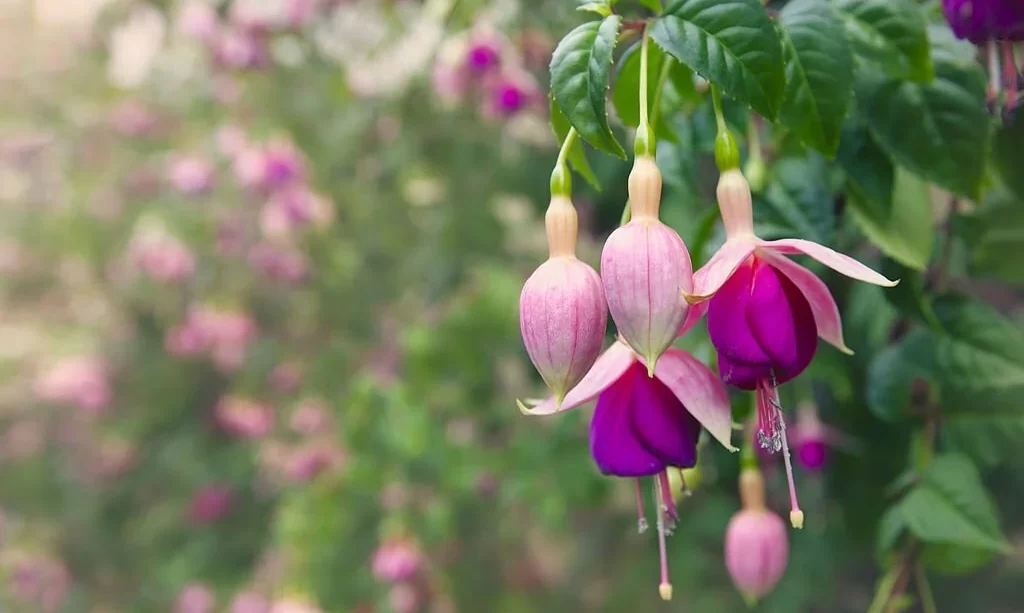Fuchsia plants, with their elegant drooping flowers in vibrant hues, are popular choices for gardens and hanging baskets. Propagating fuchsia allows gardening enthusiasts to expand their collection, share these beautiful plants, and preserve cherished varieties. This article provides a comprehensive guide on how to propagate fuchsia, offering insights into various methods and tips for successful reproduction.
Fuchsia Propagation Methods
Fuchsia propagation involves several methods, each offering its own set of advantages and challenges. The three primary propagation methods are through seeds, cuttings, and division. Choosing the appropriate method depends on factors such as the availability of resources, the desired quantity of plants, and the specific characteristics of the fuchsia variety being propagated. Understanding these methods is crucial for gardeners looking to expand their fuchsia collection or share these delightful plants with others.
Propagating Fuchsia from Seeds
Propagating fuchsia from seeds is an exciting and rewarding process that allows gardeners to explore the genetic diversity of these plants. To begin, collect mature fuchsia seeds from the spent flowers. Ensure the seeds are fully ripe before harvesting. Once collected, clean the seeds and remove any pulp or debris.
Prepare a seed-starting mix or use a well-draining potting mix to sow the fuchsia seeds. Lightly press the seeds into the soil surface, and cover them with a thin layer of the mix. Maintain a consistently moist environment by misting or covering the container with plastic wrap.
Germination typically takes a few weeks, and once the seedlings have developed true leaves, they can be transplanted into individual pots. Provide adequate light and gradually acclimate the young plants to outdoor conditions.
Propagating fuchsia from seeds allows for the discovery of unique variations and is an excellent way to start a fuchsia plant from scratch. However, it requires patience as fuchsia plants grown from seeds may take some time to reach maturity and produce flowers.
Propagating Fuchsia from Cuttings
One of the most common and efficient methods for fuchsia propagation is through cuttings. Selecting suitable cuttings is crucial for success. Choose young, healthy stems with no signs of disease or pest damage. Cuttings should be taken from the parent plant during the growing season, ideally in spring or early summer.
Prepare the cuttings by removing the lower leaves and any flower buds. Treat the cut ends with rooting hormone to encourage root development. Place the cuttings in a well-draining rooting medium, either in pots or directly in the garden soil. Keep the medium consistently moist, and provide a warm and humid environment to facilitate root growth.
Rooting typically takes a few weeks, and once the cuttings have established roots, they can be transplanted into individual pots or directly into the garden. Propagating fuchsia from cuttings allows for the retention of specific traits from the parent plant and often results in quicker establishment and flowering compared to seed-grown plants.
Propagating Fuchsia through Division
Another effective method of fuchsia propagation is through division. This method is suitable for fuchsia varieties that develop multiple stems from the base. To propagate through division, carefully dig up the parent plant, ensuring that you retain a portion of the root system.
Divide the plant into sections, making sure each section has a healthy portion of roots and stems. Trim away any damaged or unhealthy parts. Transplant the divided sections into individual containers or directly into the garden, providing them with appropriate care and attention.
Propagating fuchsia through division is a quick way to increase the number of plants with the same characteristics as the parent. It’s particularly useful for revitalizing older or overgrown fuchsia plants, promoting healthier growth and better flowering.
General Tips for Successful Fuchsia Propagation
Regardless of the chosen propagation method, there are general tips that apply to ensure successful fuchsia propagation:
Timing and Seasonal Considerations:
- Choose the appropriate season for propagation based on the method used.
- Spring and early summer are generally ideal for both cuttings and division.
Soil and Potting Mix Recommendations:
- Use a well-draining potting mix for seeds, cuttings, and divisions.
- Ensure the mix is rich in organic matter.
Providing the Right Environmental Conditions:
- Maintain a warm and humid environment for cuttings and seedlings.
- Protect newly propagated plants from harsh weather conditions.
Regular Monitoring and Care During the Propagation Process:
- Keep a close eye on moisture levels in the soil.
- Monitor for signs of pests or diseases and take prompt action if needed.
By following these general tips, gardeners can enhance the success rate of fuchsia propagation, whether using seeds, cuttings, or division.
General Tips for Successful Fuchsia Propagation
Successfully propagating fuchsia requires attention to detail and adherence to specific guidelines. Here are some general tips to enhance the success of fuchsia propagation:
Timing and Seasonal Considerations:
- Choose the appropriate season for propagation based on the method used.
- Spring and early summer are generally ideal for both cuttings and division.
Soil and Potting Mix Recommendations:
- Use a well-draining potting mix for seeds, cuttings, and divisions.
- Ensure the mix is rich in organic matter.
Providing the Right Environmental Conditions:
- Maintain a warm and humid environment for cuttings and seedlings.
- Protect newly propagated plants from harsh weather conditions.
Regular Monitoring and Care During the Propagation Process:
- Keep a close eye on moisture levels in the soil.
- Monitor for signs of pests or diseases and take prompt action if needed.
Gradual Acclimatization:
- Gradually expose young plants to outdoor conditions before transplanting.
- Avoid sudden changes in environmental conditions to prevent shock.
These tips create a favorable environment for successful fuchsia propagation, ensuring that the new plants receive the care and conditions they need to thrive.
Common Issues and Troubleshooting
Despite careful attention, issues may arise during the fuchsia propagation process. Common problems include:
Root Rot:
- Ensure well-draining soil and avoid overwatering.
- Treat with fungicides if root rot is identified.
Pests:
- Inspect plants regularly for signs of pests.
- Use insecticidal soap or neem oil for eco-friendly pest control.
Lack of Rooting:
- Ensure proper humidity for cuttings.
- Consider using rooting hormone for increased success.
Disease:
- Remove and destroy infected plant material.
- Use disease-resistant varieties when possible.
Using Rooting Hormones
Rooting hormones can significantly boost the success rate of fuchsia propagation, especially when using cuttings. Rooting hormones contain auxins, which stimulate root development and improve the chances of successful rooting.
To use rooting hormones during fuchsia propagation:
- Select suitable cuttings and trim them as needed.
- Dip the cut end of each cutting into the rooting hormone, ensuring even coverage.
- Shake off excess powder to avoid excessive hormone concentrations.
- Plant the treated cuttings in the chosen rooting medium.
Rooting hormones are available in various forms, including powders, gels, and liquids. Follow the manufacturer’s instructions for the specific rooting hormone product you choose. Using rooting hormones is an effective way to encourage the development of a healthy root system, leading to robust and thriving fuchsia plants.
- Clonex is a high performance, water-based, rooting compound
- Contains a full spectrum of mineral nutrients and trace elements to nourish young roots during their formative stages
- Supplies hormones to promote root cell development
- Provides vitamins to protect delicate, new root tissue
- Ensures root production on cuttings of plants
Patience and Care After Propagation
After successfully propagating fuchsia through seeds, cuttings, or division, exercising patience and providing careful post-propagation care is essential for the continued health and development of the new plants. Here are some key considerations:
Waiting for Successful Root Development:
- Allow sufficient time for roots to establish before transplanting.
- Gradually introduce the newly propagated fuchsia plants to their final growing environment.
Post-Propagation Care and Transplanting:
- Continue to monitor soil moisture and provide adequate watering.
- Protect young plants from extreme weather conditions, gradually exposing them to outdoor elements.
By exercising patience and offering appropriate care, gardeners can ensure a successful transition for their propagated fuchsia plants.
Creative Uses for Propagated Fuchsia
Propagated fuchsia plants offer a wealth of creative possibilities in garden design and beyond:
Incorporating into Landscape Design:
- Create colorful borders or focal points with a variety of fuchsia cultivars.
- Use hanging baskets with cascading fuchsia varieties for vertical interest.
Gift-Giving Ideas:
- Share the joy of gardening by gifting propagated fuchsia plants.
- Pot them in decorative containers for a personalized touch.
Community and Educational Initiatives:
- Contribute to community gardens or plant exchanges with propagated fuchsia.
- Use propagated fuchsia as educational tools in gardening workshops or school programs.
The creative uses for propagated fuchsia extend beyond the individual garden, making these plants a versatile and enjoyable addition to various settings.
Conclusion
In conclusion, the art of propagating fuchsia opens up a world of possibilities for gardeners, enthusiasts, and community members alike. Whether choosing seeds, cuttings, or division, the process allows for the expansion of fuchsia collections, the sharing of beloved varieties, and the cultivation of unique plants. By understanding the various propagation methods, adhering to general tips, and overcoming common challenges, gardeners can embark on a rewarding journey of nurturing and growing these beautiful, vibrant plants.
As patience is exercised and care is provided post-propagation, the propagated fuchsia plants will flourish, adding splashes of color and elegance to gardens, landscapes, and thoughtful gifts. Embrace the creative uses for these plants, contributing not only to personal gardening endeavors but also to community engagement and education. Propagating fuchsia is a journey of growth, beauty, and the joy of sharing nature’s wonders.




